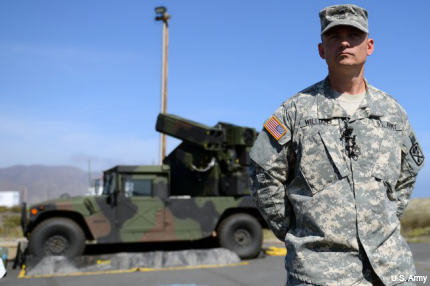At Black Dart, military takes the battle to drones
The large-scale exercise, involving all the military services, industry and some allies, seeks to refine defenses against a growing threat.

Army National Guard Master Sgt. Christopher Williams speaks with reporters at Black Dart.
The military puts plenty of effort into training personnel to fly drones. But because drones, particularly smaller ones, are easily and cheaply acquired, the services also have to think about defending against them. Small unmanned aerial systems often can fly under the radar and can be put to a variety of uses, including surveillance and targeting, delivering small bombs or supplies (even drugs to U.S. prisons.)
Finding ways to counter UAVs is the point of the Black Dart exercise going on at the Naval Base Ventura County and Sea Range, Point Mugu, Calif., where about 1,000 representatives of the four military services, industry and allied nations are testing defenses against a wide range of vehicles. Started in 2002 but kept under wraps until last year, Black Dart, being held this year July 26 to Aug. 7, is the Defense Department’s largest live-fly, live-fire counter-UAS exercise.
The exercise provides "a unique and very valuable window for us to come together for two weeks here and practice in a littoral environment, a land-based environment and a deep-sea environment in many different scenarios," Navy Cmdr. David Zook, chief of the Capabilities Assessment Division with the Joint Integrated Air and Missile Defense Organization, said in a briefing to reporters.
Defending against drones isn’t as easy as it might seem in a world where someone can shoot one down in his back yard. Shooting them down once they’re spotted is easy, but identifying them before they carry out their tasks is a challenge, especially when they’re too small to show up on conventional radar.
"Small manned and unmanned aircraft have always been hard to find," Zook said. "It's hard to tell the difference in the radar cross section from that and other small airborne vehicles or even birds."
More than 70 countries are using drones for one reason or another, the aircraft come in many varieties, and no single system is effective against every kind. So at Black Dart, participants are not just testing defensive systems but also working on interoperability among the military services. Past editions of the exercise have helped produce improvements in technology and tactics, and even led to the development of new systems, Zook said.
This year’s exercise is putting extra focus on small drones, a move at least partly inspired by the incident in January when a quadcopter landed on the White House lawn. But as UAS market grows, and as everyone from hobbyists to governments to terrorists fill the air, small aircraft have become a bigger concern for combatant commanders and law enforcement.
“It’s a problem for everyone,” said Air Force Maj. Scott Gregg, Black Dart's project officer. “The threat is expanding rapidly, proliferation is expanding rapidly and it's not just a military threat. Our allies are using them, our coalition partners are using them, but our adversaries are using them too."
Those adversaries include not only nations (China and Russia, for instance, are investing heavily in unmanned aircraft) but also, given the easy availability of drones, terrorists organizations large and small.
"If there is anything that the terrorists have shown, it's that they'll be innovative and use anything that they can at their disposal to do what they're trying to do," Gregg said.




